
Jiangxi is a province in the People's Republic of China, located in the southeast of the country. Spanning from the banks of the Yangtze river in the north into hillier areas in the south and east, it shares a border with Anhui to the north, Zhejiang to the northeast, Fujian to the east, Guangdong to the south, Hunan to the west, and Hubei to the northwest.

Yingtan is a prefecture-level city in the east of Jiangxi province, People's Republic of China, bordering Fujian to the southeast. Its location near the trisection of Jiangxi, Fujian, and Zhejiang has made it a strategically important city for centuries. Today, it continues to be a major rail transport hub. It is best known as the Capital of Copper ,and here placed Jiangxi Copper and its smelting factory.
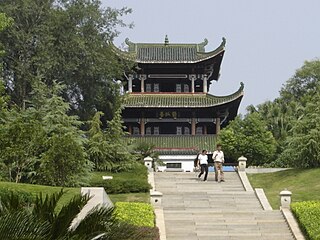
Ganzhou, formerly romanized as Kanchow, is a prefecture-level city in southern Jiangxi, China, bordering Fujian to the east, Guangdong to the south, and Hunan to the west. Its administrative seat is at Zhanggong District. Its population was 8,361,447 at the 2010 census whom 1,977,253 in the built-up area made of Zhanggong and Nankang, and Ganxian largely being urbanized.

Mount Sanqing is a renowned Taoist sacred mountain located 40 kilometres (25 mi) north of Yushan County in Jiangxi Province, China with outstanding scenery. Sanqing means the "Three Pure Ones" in Chinese as Mount Sanqing is made up of three main summits: Yujing, Yushui, and Yuhua, representing the Taoist trinity.
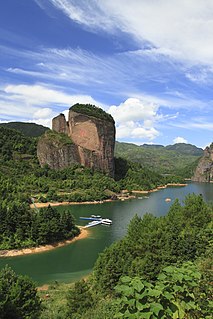
Guangfeng District is a district of the city of Shangrao, located in northeastern Jiangxi province, eastern China.

Geyuan is a town in Hengfeng County, Shangrao municipality, Jiangxi, China. As of 2018, it has one residential community and 8 villages under its administration.

The Encirclement Campaign against the Northeastern Jiangxi Soviet was a campaign launched by the Chinese Nationalist Government intended to destroy the communist Chinese Soviet Republic and its local military forces. It was met by the Communists' Counter-Encirclement Campaign at Northeastern Jiangxi Soviet, also called the Counter-Encirclement Campaign at Northeastern Jiangxi Revolutionary Base. The Nationalist campaign lasted from December 1930 to July 1931, and resulted in the destruction of the target base area.
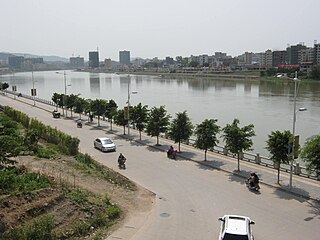
Longchuan County is a county of northeastern Guangdong province, China, bordering Jiangxi to the north and on the upper reaches of the Dong and Han Rivers. It is under the administration of Heyuan City, and in 2004 had a population of 870,000 living in an area of 3,089 km2 (1,193 sq mi). Bordering county-level divisions are Xingning and Wuhua County to the east, Heping County and Dongyuan County to the south and west, and in Jiangxi, Dingnan County and Xunwu County to the north.

Fanlu Township is a rural township in Chiayi County, Taiwan.

Geyuan Temple is a Buddhist temple located in Laiyuan, Hebei Province, China. The temple consists of three main buildings and other auxiliary structures. The main hall of the temple, the Wenshu Hall dates from 966 CE.
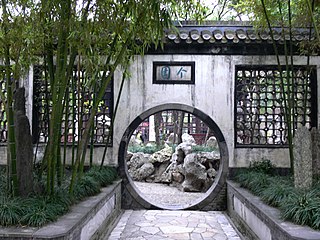
Geyuan Garden is located on Dongguan Street in Yangzhou, a city renowned for traditional private gardens, in Jiangsu Province, southeast China.
National Key Buddhist Temples in Han Chinese Area are national key ("important") Buddhist temples in areas traditionally associated with the Han Chinese in the People's Republic of China. The list was originally released on 9 April 1983 by the State Council, and included 142 Buddhist temples.
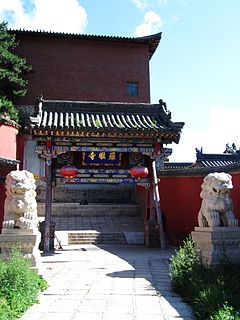
The Luohou Temple is a Buddhist temple located in Taihuai Town of Wutai County, Xinzhou, Shanxi, China.
Zhenru Temple may refer to:

The Zhenru Chan Temple is a Chan Buddhist temple located on the southwestern hillside of Mount Yunju in Yongxiu County, Jiangxi, China. Zhenru Chan Temple is the cradle of Caodong school in Chinese Buddhism. The temple has been burned down and rebuilt several times due to wars and fires. The present version was completed in the 1950s.
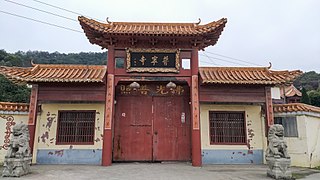
Puning Temple is a Buddhist temple located on Mount Wu'an in Yushan County, Jiangxi, China.
Puning Temple, may refer to:

The Guanyin Bridge is a stone arch bridge located on the southern Mount Lu, in Lushan, Jiangxi, China. It was built in 1014 during the reign of Emperor Zhenzong of the Song dynasty (960–1279). It is one of the earliest existing stone arch bridges in China.





















